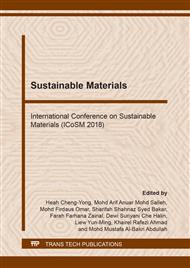p.415
p.422
p.433
p.440
p.451
p.462
p.469
p.476
p.481
Simulation of the Heat-Insulating Sludge Waste Rubber Composite Brick by the Finite Element Method (FEM)
Abstract:
Recently, materials used to construct house or building wall are considered not only in the physical material behaviour but also energy conscious and economic factor. The possibility of utilization of the sludge waste obtained from the natural rubber manufacturing process as a raw material for producing composite brick was investigated. It has been widely known that the finite element method (FEM) is a tool used for finding accurate solutions of the heat transfer equation of materials including the composite bricks. In this work, study of the heat transfer of a composite brick containing rubber sludge waste (RSW) was showed and compared to results of finite element analysis (FEA) simulation. To determine the effect of rubber sludge waste to the heat transfer behaviour of composite brick with different volume fractions are varied by 10, 20, 30, 40 and 50%. It appeared that a FEA prediction showed good correspondence with the experimental results.
Info:
Periodical:
Pages:
451-461
Citation:
Online since:
August 2018
Authors:
Price:
Сopyright:
© 2018 Trans Tech Publications Ltd. All Rights Reserved
Share:
Citation:


